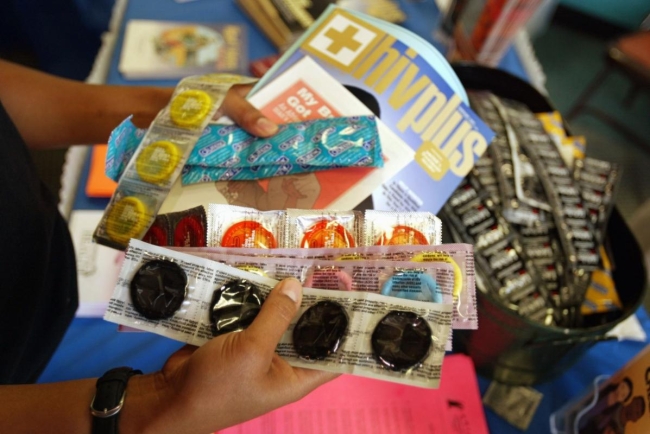You have /5 articles left.
Sign up for a free account or log in.

Students are re-engaging with sexual health resources as they return to campus.
MANAN VATSYAYANA/AFP via Getty Images
Students are returning to campus after more than a year of remote learning, and they’re ready to party. Already, reports show raucous parties on some campuses, with students drinking, dancing, socializing and hooking up until late into the night.
While students reunite with one another and their campus communities, many colleges are trying to figure out how to help them socialize responsibly by re-engaging them on matters of sexual health and sexual assault prevention.
Laura Palumbo, communications director for the National Sexual Violence Resource Center, said it’s especially important for colleges to educate new students on sexual assault prevention during the red zone, the time spanning the start of the fall semester through Thanksgiving break, when, statistically, more than 50 percent of all college sexual assaults occur.
“This fall, there is this sentiment out there from students that they may feel as though they’re making up for lost time or feel like they have lost parts of their college experience because of the past year,” Palumbo said. “And so, this return to campus is a really critical time to be reminding students about the college environment and experience that universities are hoping to create.”
Kenyora Parham, executive director of End Rape on Campus, a nonprofit organization that works to end campus sexual violence, said that the combination of a new class of freshmen and sophomores who were largely remote during their first year increases the risk of sexual assault and harassment.
“When you’re combining two classes of students who are new to campus with returning juniors and seniors who are anxious to make up for lost time and party with friends, colleges are having that potential crisis of sexual assault on their hands due to what those environments or groups may create,” Parham said.
Kim Webb, former president of the American College Health Association and current director of the relationship and sexual violence prevention center at Washington University in St. Louis, said she’s concerned about how the pandemic may have affected students’ judgment.
“I worry about how COVID has impaired decision making and how sometimes we’ve used maladaptive coping mechanisms, like alcohol,” Webb said. “We know alcohol does not cause sexual assault, but there’s definitely a correlation between inhibition, people using it in a predatory way, which are concerns that we’ve had before COVID and I think are probably exacerbated post-COVID.”
On some campuses, students are organizing their own demonstrations against sexual assault. Students at the University of Nebraska at Lincoln held multiple protests in August after a 17-year-old student reported being sexually assaulted at a fraternity. At the University of Kansas, hundreds of students gathered at a fraternity house to protest another reported sexual assault of student. Those protests inspired students at Auburn University to hold a large protest on campus after there were three different reports of sexual assault in just one week.
Palumbo added that contrary to what many people think, the absence of students on campus last year did not eliminate the issue of sexual assault. Since some students stayed in campus housing and others remained in housing just off campus, sexual violence still occurred.
“The pandemic didn’t eradicate the issue of sexual harassment and assault,” Palumbo said. “It changed the conditions under which the abuse may have been happening.”
Webb added that sexual violence may have increased during the pandemic because students were trapped in forced-choice housing -- meaning they were stuck living in unsafe households.
Preparing for the New Semester
Institutions’ top priority as the school year gets underway should be to prevent and respond to claims of sexual harassment, sexual violence and other forms of gender-based violence that occur on campus, Parham said. Colleges need to have impartial and impromptu responses for investigating and adjudicating reported cases of assault and sexual harassment, as well as provide mental health resources and accommodations to the students who report it. At the same time, it’s important that all students know their role in preventing sexual violence on campus.
“It’s about all students, regardless if they’re a survivor or not, to understand what their rights are and how they react in certain situations, and be of support to those who are impacted by sexual violence,” Parham said.
Currently, ACHA is working on what bystander intervention looks like on campuses with COVID restrictions in place, Webb said. In 2020, Webb wrote a tool kit along with ACHA on addressing sexual and relationship violence.
Jordan McCann, chair of the ACHA sexual health coalition and assistant director for sexual and relationship health at James Madison University, said the pandemic really forced colleges to find alternatives to in-person sexual health education and work “to make learning online and virtual learning still engaging.”
Colleges had to create sexual education materials that had a “longer shelf life,” she said, including videos and social media posts promoting different sexual health resources students could access. While some students are eager to socialize, McCann said, others feel anxious about relearning how to engage with their peers after more than a year of isolation.
Though she hasn’t noticed increased student sexual activity now that they’re back on campus, colleges still need to be vigilant about educating students, she said. That means informing them about birth control options, providing condoms and teaching safe-sex practices to help them prevent sexually transmitted infections and unintended pregnancies. Students should also be made aware where on campus they can get STI testing, she said.
Gwen Sieving, manager of sexual health and outreach initiatives at Colorado State University, said that unlike last year, this year the university was able to offer a summer institute for all incoming athletes around sexual health, including information about contraceptives. The university supplies athletes with condoms and other contraceptives throughout the year, she said.
The campus has also brought back its popular sexual health supply delivery service, which lets resident assistants request supplies such as condoms and other contraceptives, which the university delivers to their dorms. The RAs then distribute them to students. Fraternities and sororities can receive deliveries as well, and students can get contraceptives and other sexual health supplies at the campus food pantry.
“I can tell you that it’s been very busy,” Sieving said. “Compared to last year, we’re just getting a lot of requests, and we look at that as a good thing.”
Power to Decide, a national campaign to prevent unplanned pregnancy, works with colleges to educate students on sexual and reproductive health. Since the pandemic started, the organization had to shift from mostly in-person events to online programming, including workshops and presentations on sexual health.
“We’re still doing live virtual work but making sure that colleges have the resources they need to re-engage students back on campus in person, whether that’s through their student health services, their housing services or working with RAs,” said JeNeen Anderson, director of field service.
Anderson said in the past, students enjoyed in-person programming on sexual health education because it allowed them to have an “open, honest and nonjudgmental conversation.”
“We had to scale back and really think about how we still have these conversations, workshops, presentations with young people in school, but do it in an engaging manner virtually, which a lot of times it can be challenging to do over Zoom,” Anderson said.
Now that it’s back in person, James Madison University has resumed peer-to-peer education on sexual health, which offers students a different level of relatability, McCann said. She added that the use of TikTok, Instagram stories and other social media has helped keep students engaged in sexual health.
The Bedsider TikTok account, for example, shows videos and offers a free birth control support network, where a professional answers student questions about reproductive health, such as whether one needs to be sexually active to use birth control, or if transgender people need contraception. The Rape, Abuse and Incest National Network’s (RAINN) TikTok posts videos demonstrating how to practice bystander intervention and self-care.
At Colorado State, Sieving said the best way to educate students on sexual health is for her office to work in partnership with other campus departments, including athletics and housing.
Anderson listed the key guidelines every campus should follow to educate students on sexual health. The biggest is to address the subject openly and without judgment, so that students feel free to ask questions and initiate conversations, she said. In addition, institutions should increase accessibility to contraception -- including the emergency morning-after pill, she said -- and continue to offer online sexual health services.
“Just because students are coming back on campus this fall doesn’t mean that student health centers should do away with telehealth services,” Anderson said. “You want to be able to give young people as many options as they can to be able to access services.”




